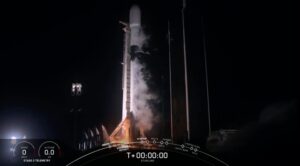SpaceX launches Starlink and BlackSky satellites
By Jeff Foust

WASHINGTON — A SpaceX Falcon 9 launched the latest set of the company’s Starlink satellites, along with two BlackSky imaging satellites, Aug. 7 after weeks of delays.
The Falcon 9 lifted off from Launch Complex 39A at the Kennedy Space Center at 1:12 a.m. Eastern. After a pair of burns, the upper stage deployed BlackSky’s Global-7 satellite nearly 62 minutes after launch, followed by the Global-8 satellite five minutes later. The primary payload, 57 Starlink satellites deployed 93 minutes after launch.
The mission was significantly longer than other recent Starlink launches, which have deployed Starlink satellites as little as 15 minutes after liftoff. The company explained on its webcast of the launch that it performed a brief second burn of the upper stage 45 minutes after liftoff to circularize the orbit for the BlackSky satellites.
The rocket’s first stage, making its fifth flight, landed on a droneship in the Atlantic Ocean about eight and a half minutes after liftoff. The stage first flew on the Demo-1 uncrewed test flight of the Crew Dragon spacecraft in March 2019, then launched the three Radarsat Constellation Mission satellites in June 2019 and Starlink missions in January and April.
SpaceX also deployed two boats to attempt to capture the payload fairing halves from the launch. The company, though, said during the launch webcast that effort was unsuccessful.
This launch was originally scheduled for late June but postponed several times because of poor weather and technical issues. The company never explained the technical issues that delayed those launch attempts, saying only it needed “additional time for pre-launch checkouts” or “to allow more time for checkouts,” according to tweets by the company on June 26 and July 11, respectively.
During the webcast, John Insprucker, principal integration engineer at SpaceX, said the delays were not caused by the rocket itself. “Through all of this, Falcon 9 has been trouble-free, as the delays have been weather-related and payload-related,” he said. He did not disclose if the payload problems were with the Starlink or BlackSky satellites.
The launch is the tenth SpaceX Starlink mission, placing 595 Starlink satellites into orbit, excluding two experimental “Tintin” satellites launched in February 2018. SpaceX ultimately plans a constellation of thousands of Starlink satellites to provide broadband internet access, and is preparing a beta test of the service to customers in parts of North America later this year.
The large number of Starlink satellites has raised concern among astronomers about interference with their observations. In an effort to reduce their brightness, SpaceX equipped one satellite on a Starlink mission in June with visors to block sunlight from reflecting off the spacecraft. While that “VisorSat” is still reaching its operational orbit, SpaceX said all 57 Starlink satellites on this latest launch are equipped with visors.
The two BlackSky satellites on this launch join four others launched in 2018 and 2019. The company hopes to have 16 of the satellites, which provide high-resolution imagery, in orbit by early 2021.
August 7, 2020 at 05:46PM
via SpaceNews read more...

Post a Comment